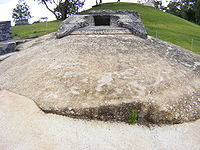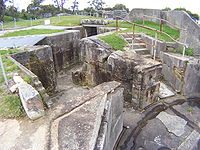
Georges Head Battery
Encyclopedia

Mosman, New South Wales
Mosman is a suburb on the Lower North Shore of Sydney, in the state of New South Wales, Australia. Mosman is located 8 kilometres north-east of the Sydney central business district and is the administrative centre for the local government area of the Municipality of Mosman.-Localities:In February...
in Sydney
Sydney
Sydney is the most populous city in Australia and the state capital of New South Wales. Sydney is located on Australia's south-east coast of the Tasman Sea. As of June 2010, the greater metropolitan area had an approximate population of 4.6 million people...
, New South Wales
New South Wales
New South Wales is a state of :Australia, located in the east of the country. It is bordered by Queensland, Victoria and South Australia to the north, south and west respectively. To the east, the state is bordered by the Tasman Sea, which forms part of the Pacific Ocean. New South Wales...
, Australia
Australia
Australia , officially the Commonwealth of Australia, is a country in the Southern Hemisphere comprising the mainland of the Australian continent, the island of Tasmania, and numerous smaller islands in the Indian and Pacific Oceans. It is the world's sixth-largest country by total area...
. The Georges Head battery is one of three forts in the area that were built for the purpose of defending the outer harbour. The fort became a command post in the 1890s for the coordination of all of Sydney's harbour defences.
Sydney Harbour defences
Sydney Harbour was protected by coastal batteries and other fixed defences from the early 19th century until the 1960s. These defences were constructed to protect the Australian city of Sydney from attack by enemy warships and submarines....
1870s




Georges Head Battery was an outer line harbour defence fortification designed especially to attack and prevent enemy ships from infiltrating the inner harbour. The fort held a prominent position and was located high above sea level with strategic views to the entrance (Sydney Heads
Sydney Heads
Sydney Heads , is the entrance to Port Jackson in Sydney, New South Wales, Australia.North Head and Quarantine Head are to the north, South Head and Dunbar Head are to the south. Middle Head, Georges Head and Chowder Head are to the west and within the bay...
) of Port Jackson. Other batteries were located on Middle Head, South Head, Shark Point and Bradleys Head, but none were ever used for combative purposes.
Georges Head was armed with four 80 pounder rifled muzzle loading guns and two 68 pounder muzzle-loading guns. It took three months and 250 soldiers to roll the gun barrels all the way from North Sydney to the batteries. They came along a rough track which later became Military Road. The guns had been positioned so poorly that this created the risk of one gun firing upon another. Also, the guns and soldiers were visible from the harbour. In 1877 large mounds of earth were placed between the pits to make sure the guns could not fire upon each other
Friendly fire
Friendly fire is inadvertent firing towards one's own or otherwise friendly forces while attempting to engage enemy forces, particularly where this results in injury or death. A death resulting from a negligent discharge is not considered friendly fire...
and to help protect the gun crew from enemy fire. When construction of the fort was complete, there were a total of 41 gun emplacements positioned around the harbour.
Defence tactics were planned using telescopes and plotters mounted in the middle of the second gun pit. From the telephone exchange, the Port Jackson District Commandant could communicate with all military installations on the harbour. Telephone cables ran through the tunnels, down the cliff and under the harbour to batteries on the other side.
1880s



The work of the submarine miner was secretive, technical and dangerous. During a demonstration in 1891, a crowd of several thousand watched as a terrible accident killed four miners and injured another eight.
World War II
In 1942, during the Second World War, the 'Sydney Harbour anti-submarine boom net' was installed. The boom net spanned the entire width of Sydney Harbour from Green (Laings) Point, Watsons BayWatsons Bay, New South Wales
Watsons Bay is a harbourside, eastern suburb of Sydney, in the state of New South Wales, Australia. Watsons Bay is located 11 km north-east of the Sydney central business district, in the local government area of the Municipality of Woollahra....
to Georges Heights in Mosman
Mosman, New South Wales
Mosman is a suburb on the Lower North Shore of Sydney, in the state of New South Wales, Australia. Mosman is located 8 kilometres north-east of the Sydney central business district and is the administrative centre for the local government area of the Municipality of Mosman.-Localities:In February...
The command post remained until the 1930s. The area then became home to various defence bases until 2002 when the Army left after 130 years at Georges Head. The area in which the fortifications are situated is now open to the public and the Harbour Trust has restored the historic fortifications, creating a new type of lookout.
Casualty clearing station & storage facility

The floor was originally covered in a bituminous substance, the walls were tiled with ceramic tiles not unlike those seen on the wall pictured, and the tunnel ceiling leading to the room was lined with cork. The purpose of these measures was to reduce the possibility of sparks and the potential for a powder explosion. The zigzag tunnel at the far end of the room was designed to act as a blast wall to contain any blast within the immediate area.
The room has been modified since 1872 and was used as a casualty clearing station in 1932/33 when the battery was re-gunned with the 6 inch breech loaded MK7 guns
BL 6 inch Mk VII naval gun
The BL 6 inch Gun Mark VII was a British naval gun dating from 1899, which was mounted on a heavy traveling carriage in 1915 for British Army service to become one of the main heavy field guns in the First World War, and also served as one of the main coast defence guns throughout the British...
. Designed for emergencies only, it fortunately saw no casualties of war.

